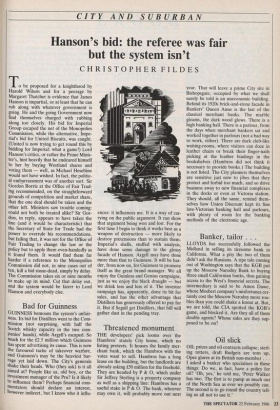Threatened monument
THE developers' pick looms over the Hambros' stately City home, which no listing protects. It houses the family mer- chant bank, which the Hambros with the votes want to sell. Hambros has a long lease on the building, but the landlords are already asking £50 million for the freehold. They are headed by P & 0, which under Sir Jeffrey Sterling is a property company as well as a shipping line: Hambros has a useful stake in P & 0. The bank, whoever may own it, will probably move out next year. That will leave a prime City site in Bishopsgate, occupied by what we shall surely be told is an uneconomic building. Behind its 1920s brick-and-stone facade in Bankers' Queen Anne is the last of the classical merchant banks. The marble gleams, the dark wood glows. There is a high banking hall. There is a parlour, from the days when merchant bankers sat and worked together in parlours (not a bad way to work, either). There are dark club-like waiting-rooms, where visitors can doze in leather chairs or break their finger-nails picking at the leather bindings in the bookshelves (Hambros did not think it necessary to provide books.) The building is not listed. The City planners themselves are sensitive just now to jibes that they protect and forbid too much, and so drive business away to new financial complexes in the docks or even at Victoria station. They should, all the same, remind them- selves how Union Discount kept its fine late-Victorian banking hall and parlours, with plenty of room for the banking methods of the electronic age.














































 Previous page
Previous page